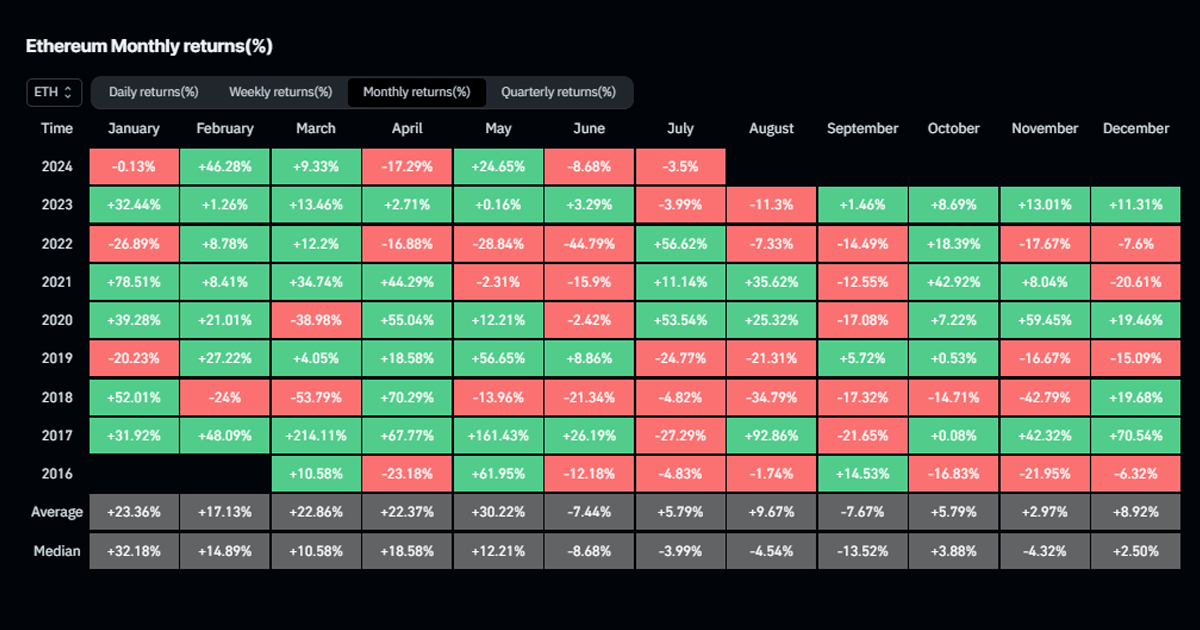Ethereum
Ethereum’s Pectra upgrade could be split into two forks

Developers have already crafted nine EIPs to include in the upcoming Ethereum hard fork.
With Ethereum’s upcoming Pectra upgrade shaping up to be the most extensive in the network’s history, developers are considering splitting its rollout over two separate hard forks.
Following the last run of All Core Devs call on June 6, Christine Kim, researcher at Galaxy Digital, tweeted that the developers plan to run the upgrade across two forks.
Kim noted that the inclusion of nine Ethereum Improvement Proposals (EIPs) has already been confirmed, and five additional upgrades are under consideration. She added that upgrades are done in batches in devnet implementations, allowing Pectra’s scope to expand before deployment.
“That’s A LOT for a single upgrade, so there’s still a good chance Pectra will be split,” Kim said. “Putting multiple EIPs in place for implementation on devnets is a new development for Ethereum’s governance process that leaves the door open for an upgrade with an ever-changing scope.”
Pectra’s upcoming Devnet 1 will include the same eight EIPs tested on Devnet 0.
Disruptive changes
According to Ethereum Chief Scientist Vitalik Buterin, Pectra is among the latest expected upgrades. disruptive changes to Ethereum.
“Once scaling is complete, we are in a stage where the hardest and fastest parts of the Ethereum protocol transition are essentially complete,” Buterin said during a Foundation livestream Ethereum in April 2023. “Various things will need to be done, but these… things can be done safely at a slower pace.
Five execution layer upgrades and four consensus layer upgrades have been “finalized» to be included as part of Pectra thus far, covering an eclectic assortment of EIPs dating back to 2020.
Verkle Trees and Statelessness
EIP-2935 is an essential component of Pectra necessary to facilitate the introduction of Verkle Trees and statelessness. Verkle Trees will remove the need for nodes to store network state locally, significantly reducing the computational requirements of validators.
According to Kim, the developers are also working on three “parallel upgrades” that will likely be integrated into Pectra.
These include validator development thin clients, which do not download the entire Ethereum blockchain. Light clients are intended to improve Ethereum’s decentralization by allowing users to validate the network using “resource-constrained devices such as tablets and mobile phones.”
As nodes are no longer needed to store the entire history of Ethereum blocks, EIP-4444 would also formalize the removal of historical data from full nodes after a set amount of time, further reducing the computational demands of validators with the aim of improving node decentralization.
“With EIP-4444: History Expiration, you would not need to store most of the history locally,” Buterin said. “The amount of data you would need to be a node would go from several terabytes to… being able to run a node in RAM.”
DApps and other nodes that need to access deleted block history could query third-party data services after EIP-4444 is deployed.
Developers are also exploring PeerDASwhich would provide greater availability of Layer 2 data after the introduction of proto-danksharding in March.
Consensus layer upgrades
Many of the upgrades planned for inclusion in Pectra aim to improve the functionality and efficiency of Ethereum staking.
EIP-6110 aims to reduce the delay between the posting of collateral by actors on the execution layer of the Ethereum mainnet and the processing of corresponding transactions on the Beacon chain. This would also reduce the complexity of the validator client software.
EIP-7251 aims to slow the growth and reduce the size of Ethereum’s validator in order to strengthen the security of the network. EIP-7002 would increase the number of designs available to developers creating staking pools.
EIP-7549 aims to improve the efficiency of attestations, which would reduce network load and node bandwidth demands.
Runtime Layer Upgrades
On the execution layer, EIP-2537 And EIP-7865 would strengthen interoperability between the Ethereum mainnet and its Beacon Chain consensus layer. This would extend the functionality of decentralized staking pools, DAOs, and dApps that communicate with the Beacon Chain for staking functions.
A set of ten EIPs relating to EVM Object Format (EOF) aims to modernize the Ethereum Virtual Machine, Ethereum’s main smart contract engine. EOF would improve the scalability of EVM contracts as well as the efficiency of smart contract code execution.
EIP-7702 is a controversial upgrade that would “enablesmart account” Features for regular External Account (EOA) wallets. The upgrade would enable batch trade execution, transaction fee sponsorship, and delegated wallet security, but critics warned the upgrade could make users vulnerable to new attack vectors.
“It’s important to note that developers are staging Pectra EIPs, which means that if EOF, EIP-7702, or PeerDAS does not become a devnet in the next few months, developers could remove it from deployment entirely. level or split Pectra in two. two hard forks,” Kim said.
Unconfirmed upgrades
Kim noted two additional upgrades to the consensus layer that the developers have not yet confirmed for inclusion in Pectra.
EIP-7688 would make it easier for staking pools to check if a participating validator has been minted.
Developers may also consider reduce the rate of new Ether issuance. Mike Neuder, a researcher at the Ethereum Foundation, recently made the case for such a move, arguing that the Ethereum network and ecosystem have undergone a “seismic” change since Ether’s staking reward mechanism was finalized. as part of preparations for the deployment of the Beacon Chain in 2020.
However, the proposal quickly proved divisive, with many community members opposing Nueder’s suggestion. Some observers feared that this could open the door to Ethereum Foundation researchers frequently meddling in the network’s tokenomics without input from the broader community.
Ethereum
QCP sees Ethereum as a safe bet amid Bitcoin stagnation

QCP, a leading trading firm, has shared key observations on the cryptocurrency market. Bitcoin’s struggle to surpass the $70,000 mark has led QCP to predict Selling pressure is still strong, with BTC likely to remain in a tight trading range. In the meantime, Ethereum (ETH) is seen as a more promising investment, with potential gains as ETH could catch up to BTC, thanks to decreasing ETHE outflows.
Read on to find out how you can benefit from it.
Bitcoin’s Struggle: The $70,000 Barrier
For the sixth time in a row, BTC has failed to break above the $70,000 mark. Bitcoin is at $66,048 after a sharp decline. Many investors sold Bitcoin to capitalize on the rising values, which caused a dramatic drop. The market is becoming increasingly skeptical about Bitcoin’s rise, with some investors lowering their expectations.
Despite the continued sell-off from Mt. Gox and the US government, the ETF market remains bullish. There is a notable trend in favor of Ethereum (ETH) ETFs as major bulls have started investing in ETFs, indicating a bullish sentiment for ETH.
QCP Telegram Update UnderlinesIncreased market volatility. The NASDAQ has fallen 10% from its peak, led by a pullback in major technology stocks. Currency carry trades are being unwound and the VIX, a measure of market volatility, has jumped to 19.50.
The main factors driving this uncertainty are Value at Risk (VaR) shocks, high stock market valuations and global risk aversion sentiment. Commodities such as oil and copper have also declined on fears of an economic slowdown.
Additionally, QCP anticipates increased market volatility ahead of the upcoming FOMC meeting, highlighting the importance of the Federal Reserve’s statement and Jerome Powell’s subsequent press conference.
A glimmer of hope
QCP notes a positive development in the crypto space with an inflow of $33.7 million into ETH spot ETFs, which is giving a much-needed boost to ETH prices. However, they anticipate continued outflows of ETHE in the coming weeks. The recent Silk Road BTC moves by the US government have added to the market uncertainty.
QCP suggests a strategic trade involving BTC, which will likely remain in its current range, while ETH offers a more promising opportunity. They propose a trade targeting a $4,000-$4,500 range for ETH, which could generate a 5.5x return by August 30, 2024.
Ethereum
Ethereum Whale Resurfaces After 9 Years, Moves 1,111 ETH Worth $3.7 Million

An Ethereum ICO participant has emerged from nearly a decade of inactivity.
Lookonchain, a smart on-chain money tracking tool, revealed On X, this long-inactive participant recently transferred 1,111 ETH, worth approximately $3.7 million, to a new wallet. This significant move marks a notable on-chain movement, given the participant’s prolonged dormancy.
The Ethereum account in question, identified as 0xE727E67E…B02B5bFC6, received 2,000 ETH on the Genesis block over 9 years ago.

This initial allocation took place during the Ethereum ICOwhere the participant invested in ETH at around $0.31 per coin. The initial investment, worth around $620 at the time, has now grown to millions of dollars.
Recent Transactions and Movements
The inactive account became active again with several notable output transactions. Specifically, the account transferred 1,000 ETH, 100 ETH, 10 ETH, 1 ETH, and 1 more ETH to address 0x7C21775C…2E9dCaE28 within a few minutes. Additionally, it moved 1 ETH to 0x2aa31476…f5aaCE9B.
Additionally, in the latest round of transactions, the address transferred 737,995 ETH, 50 ETH, and 100 ETH, for a total of 887,995 ETH. These recent activities highlight a significant movement of funds, sparking interest and speculation in the crypto community.
Why are whales reactivating?
It is also evident that apart from 0xE727E67E…B02B5bFC6, other previously dormant Ethereum whales are waking up with significant transfers.
In May, another dormant Ethereum whale made headlines when it staked 4,032 ETHvalued at $7.4 million, after more than two years of inactivity. This whale initially acquired 60,000 ETH during the Genesis block of Ethereum’s mainnet in 2015.
At the time, this activity could have been related to Ethereum’s upgrade known as “Shanghai,” which improved the network’s scalability and performance. This whale likely intended to capitalize on the price surge that occurred after the upgrade.
Disclaimer: This content is informational and should not be considered financial advice. The opinions expressed in this article may include the personal opinions of the author and do not reflect the opinion of The Crypto Basic. Readers are encouraged to conduct thorough research before making any investment decisions. The Crypto Basic is not responsible for any financial losses.
-Advertisement-
Ethereum
Only Bitcoin and Ethereum are viable for ETFs in the near future

BlackRock: Only Bitcoin and Ethereum Are Viable for ETFs in the Near Future
Bitcoin and Ethereum will be the only cryptocurrencies traded via ETFs in the near future, according to Samara Cohen, chief investment officer of ETFs and indices at BlackRock, the world’s largest asset manager.
In an interview with Bloomberg TV, Cohen explained that while Bitcoin and Ethereum have met BlackRock’s rigorous criteria for exchange-traded funds (ETFs), no other digital asset currently comes close. “We’re really looking at the investability to see what meets the criteria, what meets the criteria that we want to achieve in an ETF,” Cohen said. “Both in terms of the investability and from what we’re hearing from our clients, Bitcoin and Ethereum definitely meet those criteria, but it’s going to be a while before we see anything else.”
Cohen noted that beyond the technical challenges of launching new ETFs, the demand for other crypto ETFs, particularly Solana, is not there yet. While Solana is being touted as the next potential ETF candidate, Cohen noted that the market appetite remains lacking.
BlackRock’s interest in Bitcoin and Ethereum ETFs comes after the successful launch of Ethereum ETFs last week, which saw weekly trading volume for the crypto fund soar to $14.8 billion, the highest level since May. The success has fueled speculation about the next possible ETF, with Solana frequently mentioned as a contender.
Solana, known as a faster and cheaper alternative to Ethereum, has been the subject of two separate ETF filings in the US by VanEck and 21Shares. However, the lack of CME Solana futures, unlike Bitcoin and Ethereum, is a significant hurdle for SEC approval of a Solana ETF.
Despite these challenges, some fund managers remain optimistic about Solana’s potential. Franklin Templeton recently described Solana as an “exciting and major development that we believe will drive the crypto space forward.” Solana currently accounts for about 3% of the overall cryptocurrency market value, with a market cap of $82 billion, according to data from CoinGecko.
Meanwhile, Bitcoin investors continue to show strong support, as evidenced by substantial inflows into BlackRock’s iShares Bitcoin Trust (NASDAQ: IBIT). On July 22, IBIT reported inflows of $526.7 million, the highest single-day total since March. This impressive haul stands in stark contrast to the collective inflow of just $6.9 million seen across the remaining 10 Bitcoin ETFs, according to data from Farside Investors. The surge in IBIT inflows coincides with Bitcoin’s significant $68,000 level, just 8% off its all-time high of $73,000.
Ethereum
Ethereum Posts First Consecutive Monthly Losses Since August 2023 on New ETFs

Available exclusively via
Bitcoin ETF vs Ethereum: A Detailed Comparison of IBIT and ETHA
Andjela Radmilac · 3 days ago
CryptoSlate’s latest market report takes an in-depth look at the technical and practical differences between IBIT and BlackRock’s ETHA to explain how these products work.
-

 Ethereum12 months ago
Ethereum12 months agoEthereum Posts First Consecutive Monthly Losses Since August 2023 on New ETFs
-

 Regulation12 months ago
Regulation12 months agoCryptocurrency Regulation in Slovenia 2024
-

 News12 months ago
News12 months agoNew bill pushes Department of Veterans Affairs to examine how blockchain can improve its work
-

 Regulation12 months ago
Regulation12 months agoThink You Own Your Crypto? New UK Law Would Ensure It – DL News
-

 Regulation12 months ago
Regulation12 months agoUpbit, Coinone, Bithumb Face New Fees Under South Korea’s Cryptocurrency Law
-

 Regulation12 months ago
Regulation12 months agoA Blank Slate for Cryptocurrencies: Kamala Harris’ Regulatory Opportunity
-

 Regulation12 months ago
Regulation12 months agoBahamas Passes Cryptocurrency Bill Designed to Prevent FTX, Terra Disasters
-

 Regulation12 months ago
Regulation12 months agoIndia to Follow G20 Policy for Cryptocurrency Regulation: MoS Finance
-

 News1 year ago
News1 year ago“Captain Tsubasa – RIVALS” launches on Oasys Blockchain
-

 Ethereum1 year ago
Ethereum1 year agoComment deux frères auraient dérobé 25 millions de dollars lors d’un braquage d’Ethereum de 12 secondes • The Register
-

 News1 year ago
News1 year agoSolana ranks the fastest blockchain in the world, surpassing Ethereum, Polygon ⋆ ZyCrypto
-

 News12 months ago
News12 months agoEU supports 15 startups to fight online disinformation with blockchain





